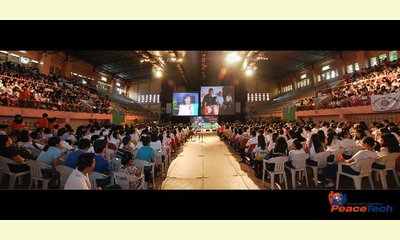|
|
Peace building goes HIGH TECH
an article by Meg Villanueva
Imagine people from different backgrounds being able to speak with one another, live, on giant
screens!

Video-conference in Iligan City
click on photo to enlarge
Fortunately for me, I have seen it happen! As one
of the first few people to work on the PeaceTech
project when it first started in 2006 in the Philippines, I remember how amazing it felt to be able to bring thousands of young students from 2 different communities – 2 separate regions at that!
Since then, PeaceTech, a non-profit, non-governmental organization has evolved with much improvement
in the use of information communication technology to build understanding and respect between young
people throughout the Philippines. PeaceTech has conducted more than 8 video-conferences on a mass
scale, connecting 2 cities in the Philippines (one from the north, considered with majority
Christians, and one from the south, usually with majority Muslim students).
PeaceTech uses technology to bring people from different groups together across large distances –
building more knowledge, more understanding and more trust. More concretely, through live
video-conferences, PeaceTech aims to tackle the structural causes leading to conflict, clarify
misinterpretations about issues and reduce ignorance. It promotes solidarity, and empowers people, especially the youth.
It boasts of three years of experience in the peace-building process in cities throughout Indonesia
and the Philippines. The organization has worked with a range of groups from different backgrounds,
including: victims of armed conflict and discrimination; former insurgents and child soldiers; and
religious fundamentalists and moderates. At present, PeaceTech organizes a series of classroom
video-conferences between thousands of high school and college students in Metro Manila, Zamboanga
City, Iligan City and other Mindanao locations. Over 50 classroom video-conferences have already
been conducted. Another project of PeaceTech is LAPTOP, which means Linking Awareness of Peace and
Technology to Other People. One of the highlights of LAPTOP is the understanding of peace by
promoting dialogue, and dialogue through technology.
Clearly, this shows how communication is the cornerstone of peace-building, especially that today’s
rapidly evolving technology provides better and faster ways to communicate with every corner of the
globe. Through this program, students are able to speak first hand with someone from a different
cultural background. They learn to be open to understanding and acceptance of cultural and religious differences, and this is an important pillar of the peace-building process.
*For more information about PeaceTech Inc., please visit www.peacetech.net.
|








|
DISCUSSION
Question(s) related to this article:
How can high tech be used to promote solidarity among peoples?,
* * * * *
Latest reader comment:
In very situation, tolerance promotes solidarity. Sometimes intolerance has been due to poverty that everyone is trying to overcome under any circumstance. High tech will definitely promote efficient and effective production and productivity. Due to scarce resources, people scramble for the few resources that are available in the nation. High tech will increase the production of the same and also enhance the telecommunication system for efficient delivery of goods and services. Once this happens people will think of working together in order to achieve more thereby improving their lives further.

|
|









